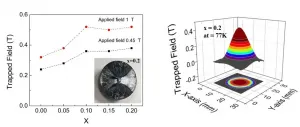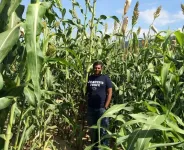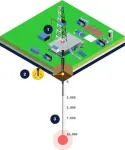Study explores how the elderly use smart speaker technology
2021-06-17
(Press-News.org) Researchers from Bentley University, in partnership with Waltham Council on Aging in Massachusetts, and as part of a study funded by the National Science Foundation, have been exploring how the elderly use smart speakers at home. Waltham, a satellite city about eight miles west of Cambridge has a population of about 60,000, with about one in six being an elderly citizen. The purpose of the study was to understand how the elderly use the smart speaker technology at home. A smart speaker is a hardware device that is always-on. When a wake-word triggers the software contained in the device, the smart speaker listens to the command to provide a response or carry out the command (accessing resources on the internet as needed). News stories about smart speakers have often contemplated issues such as privacy but often lack actual usage data.
The researchers deployed smart speakers in seven homes with individuals or couples aging-at-home over several months to collect actual usage data. The study followed research protocols and was designed to ensure confidentiality. The time period ranged from 178 days (about 6 months) to 410 days (about a year and a month) for different users. The usage data was analyzed to characterize use patterns. The biggest finding was heterogeneity in use patterns. In general, mornings and afternoons were more active, uses such music and news were most prevalent, and most interactions were simple commands as opposed to longer conversations. Most participants did not demonstrate sustained use over a long period. As an example, one participant who used the smart speaker for more than a year had an enthusiastic start, followed by moderate use (listen to the 14-second sonification here - listen to how the early high notes give way to repeating low notes).
"Smart speaker technology has the potential to be more than a surveillance or shopping device particularly for population segments such as the aging-at-home. Our study shows that the elderly can use this voice-based technology more easily. Future research can develop specific voice skills aimed at this population segment," says Dr. Sandeep Purao, a professor of information and process management and one of the lead researchers. "The usage data streams provide several opportunities for analysis that provide a window into how the elderly use the smart speaker technology," says Dr. Haijing Hao, a computer information systems professor who also participated in the study.
The results of this work are being published in the Big Data Research journal. The team will continue the work by developing software platforms for the elderly to manage health information and exploring the design of voice skills for the elderly.
The work is important. The US Census Bureau projects that by 2040, about one in five Americans will be age 65 or older, up from about one in eight in 2000. Our study shows that technologies such as smart speakers have the potential for sustained use by the elderly, and therefore, can be the basis for developing new solutions for this population segment.
INFORMATION:
Purao, S., Hao, H., and Meng, C. 2021. The Use of Smart Home Speakers by the Elderly: Exploratory Analyses and Potential for Big Data. Big Data Research. Elsevier.
https://doi.org/10.1016/j.bdr.2021.100224
http://purao.us/paper-accepted-at-big-data-research/
About Bentley University
Bentley University is more than just one of the nation's top business schools. It is a lifelong-learning community that creates successful leaders who make business a force for positive change. With a combination of business and the arts and sciences and a flexible, personalized approach to education, Bentley provides students with critical thinking and practical skills that prepare them to lead successful, rewarding careers. Founded in 1917, the university enrolls 4,200 undergraduate and 1,000 graduate and PhD students and is set on 163 acres in Waltham, Massachusetts, 10 miles west of Boston. For more information, visit http://www.bentley.edu.
ELSE PRESS RELEASES FROM THIS DATE:
2021-06-17
When Ana K. Spalding, a Research Associate at the Smithsonian Tropical Research Institute (STRI) and Assistant Professor of Marine and Coastal Policy at Oregon State University (OSU) talks about mentorship in academia, she describes it as meaningful relationship. It goes beyond conversations about research and publications, and into shared experiences. This is just one approach--proposed by Spalding and 23 other women scientists from around the world, in a new article published in PLOS Biology--that calls for a shift in the value system of science to emphasize a more equal, diverse and inclusive academic culture.
The authors came together after reading a ...
2021-06-17
Superconductors are something like a miracle in the modern world. Their unique property of zero resistance can revolutionize power transmission and transport (e.g., Maglev train). However, most of the conventional superconductors require cooling down to extremely low temperatures that can only be achieved with liquid helium, a rather expensive coolant. Material scientists are now investigating "high-temperature superconductors" (HTSs) that can be cooled to a superconducting state by using the significantly cheaper liquid nitrogen (which has a remarkably higher temperature than liquid helium). ...
2021-06-17
TROY, N.Y. -- Optoelectronic materials that are capable of converting the energy of light into electricity, and electricity into light, have promising applications as light-emitting, energy-harvesting, and sensing technologies. However, devices made of these materials are often plagued by inefficiency, losing significant useful energy as heat. To break the current limits of efficiency, new principles of light-electricity conversion are needed.
For instance, many materials that exhibit efficient optoelectronic properties are constrained by inversion symmetry, a physical property that limits engineers' control of electrons in the material and their options for designing novel or efficient devices. In research published today in Nature ...
2021-06-17
With sorghum poised to become an important crop grown by Pennsylvania farmers, Penn State researchers, in a new study, tested more than 150 germplasm lines of the plant for resistance to a fungus likely to hamper its production.
Sorghum, a close relative to corn, is valuable for yielding human food, animal feed and biofuels. Perhaps its most notable attribute is that the grain it produces is gluten free. Drought resistant and needing a smaller amount of nutrients than corn to thrive, sorghum seems to be a crop that would do well in the Keystone State's ...
2021-06-17
The article 'The RNA Atlas expands the catalog of human non-coding RNAs', published today in Nature Biotechnology, is the result of more than five years of hard work to further unravel the complexity of the human transcriptome. Never before such a comprehensive effort was undertaken to characterize all RNA-molecules in human cells and tissues.
RNAs in all shapes and sizes
Our transcriptome is - analogous to our genome - the sum of all RNA molecules that are transcribed from the DNA strands that make up our genome. However, there's no 1-on-1 relationship with the latter. Firstly, each cell and tissue hasve a unique transcriptomes, with varying RNA production and compositions, including tissue-specific RNAs. Secondly, ...
2021-06-17
Additive manufacturing offers an unprecedented level of design flexibility and expanded functionality, but the quality and process can drastically differ across production machines, according to Hui Yang, a professor of industrial engineering at Penn State. With applications in aerospace, health care and automotive industries with potential for mass customization, additive manufacturing needs quality management.
To address this concern, Yang and a team of researchers from Penn State, University of Nebraska--Lincoln and the National Institute of Standards and Technology (NIST) proposed the design, development and implementation of a new data-driven methodology for quality control in additive manufacturing. They published their work in the Proceedings ...
2021-06-17
CAMBRIDGE, MA--Geothermal energy systems have the potential to power the world and become the leading technology for reducing greenhouse gas emissions if we can drill down far enough into the Earth to access the conditions necessary for economic viability and release the heat beneath our feet. END ...
2021-06-17
SAN ANTONIO (June 17, 2021) -- Convalescent plasma therapy was associated with better survival in blood cancer patients hospitalized with COVID-19, especially in sicker patients. The findings by the COVID-19 and Cancer Consortium (CCC19) are newly published in the peer-reviewed journal JAMA Oncology.
The Mays Cancer Center, home to UT Health San Antonio MD Anderson, is part of the CCC19. The international consortium is composed of 124 medical centers and institutions in North and South America that conduct research to learn how COVID-19 affects cancer patients.
Dimpy Shah, MD, PhD, is an epidemiologist and assistant professor of population health sciences at The University of Texas Health ...
2021-06-17
Forest fires have crept higher up mountains over the past few decades, scorching areas previously too wet to burn, according to researchers from McGill University. As wildfires advance uphill, a staggering 11% of all Western U.S. forests are now at risk.
"Climate change and drought conditions in the West are drying out high-elevation forests, making them particularly susceptible to blazes," says lead author Mohammad Reza Alizadeh, a PhD student at McGill University under the supervision of Professor Jan Adamowski. "This creates new dangers for mountain communities, with impacts on downstream water supplies and the plants and wildlife that call these forests home."
Climate warming has diminished 'flammability barrier'
In ...
2021-06-17
If the genome is the recipe of life, base pairs are the individual ingredients listed. These chemical structures form DNA, and every living organism on Earth has just four. The specific arrangements of these four base pairs -- A, T, C, G -- make us who and what we are.
So it was a big surprise when Scripps Research scientists revealed in 2014 that they could introduce two new, unnatural base pairs (they called them X and Y for short) into the genetic code of living bacteria in the lab. It was like two never-seen-before ingredients tossed into the recipe, hypothetically expanding the variety of dishes a cell can whip up.
Researchers immediately saw the potential applications: With more control and selection, they ...
LAST 30 PRESS RELEASES:
[Press-News.org] Study explores how the elderly use smart speaker technology



